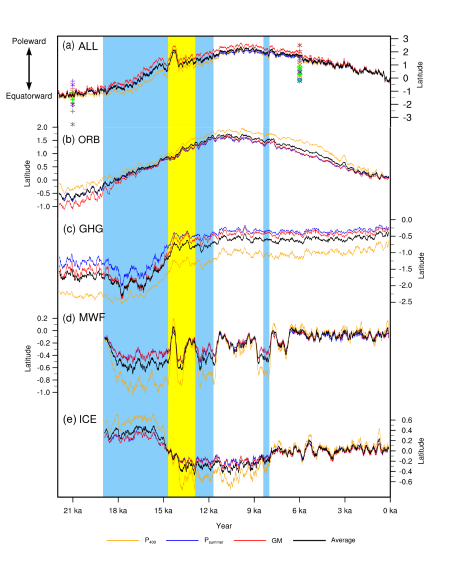您当前的位置:首页 > 科研进展
[发布日期: 2021-09-06 浏览量 5341]
东亚夏季风北界是东亚副热带夏季风每年向北推进到的最北位置,其作为表征东亚夏季风进退的有效指标之一,具有重要的气候、地理和生态意义。本文利用TraCE-21ka瞬变模拟资料,基于三个东亚夏季风北界指标,研究了过去21000年以来东亚夏季风北界在中国东部地区的迁移及其对不同外强迫的响应。研究表明,在末次冰盛期时东亚夏季风北界相对于现代北界向东南移动120–140 km,在中全新世时向西北迁移110–140 km。东亚夏季风北界在轨道尺度上的变化趋势主要由轨道强迫控制,而淡水通量强迫主导了东亚夏季风北界在千年时间尺度上的波动。轨道强迫的夏季太阳辐射增加及其导致的经向温度梯度减小和海陆热力对比增强是造成对流层低层南风增强和中国东部大部分地区整层水汽通量辐合及降水增加的主要原因,这些变化导致东亚夏季风增强及其北界向西北推移。淡水通量强迫导致的变化与轨道强迫相似,但幅度较弱。TraCE-21ka模拟的东亚夏季风北界在末次冰盛期和中全新世时的移动总体位于国际古气候模拟比较计划第四阶段(PMIP4)的多模式结果范围内。此外,模拟的东亚夏季风北界从末次冰盛期至今的变化,总体上得到了基于孢粉数据重建的中国森林-草原界限变化的支持。

Figure Temporal evolution of the meridional migration of the EASM northern boundary defined by three metrics over eastern China since the LGM compared to the present in the (a) TraCE-ALL experiment and the experiments forced by varying only (b) orbital insolation, (c) greenhouse gas concentration, (d) meltwater fluxes, and (e) continental ice sheets by a 200-year running average. The colored dot, cross, and asterisk symbols in (a) on the 21 ka and 6 ka vertical panels stand for the results of the P400, Psummer, and GM metrics, respectively, simulated by available models from the PMIP4 in the LGM and the mid-Holocene. Three cold events, namely Heinrich Stadial 1 (HS1), Younger Dryas (YD), and 8.2 ka event, are marked as the blue vertical panels, and the Bølling-Allerød (BA) warm event is marked as the yellow vertical panel.
引用格式:
Wu, B., Lang, X., & Jiang, D. 2021. Migration of the northern boundary of the East Asian summer monsoon over the last 21,000 years. Journal of Geophysical Research: Atmospheres, 126, e2021JD035078.